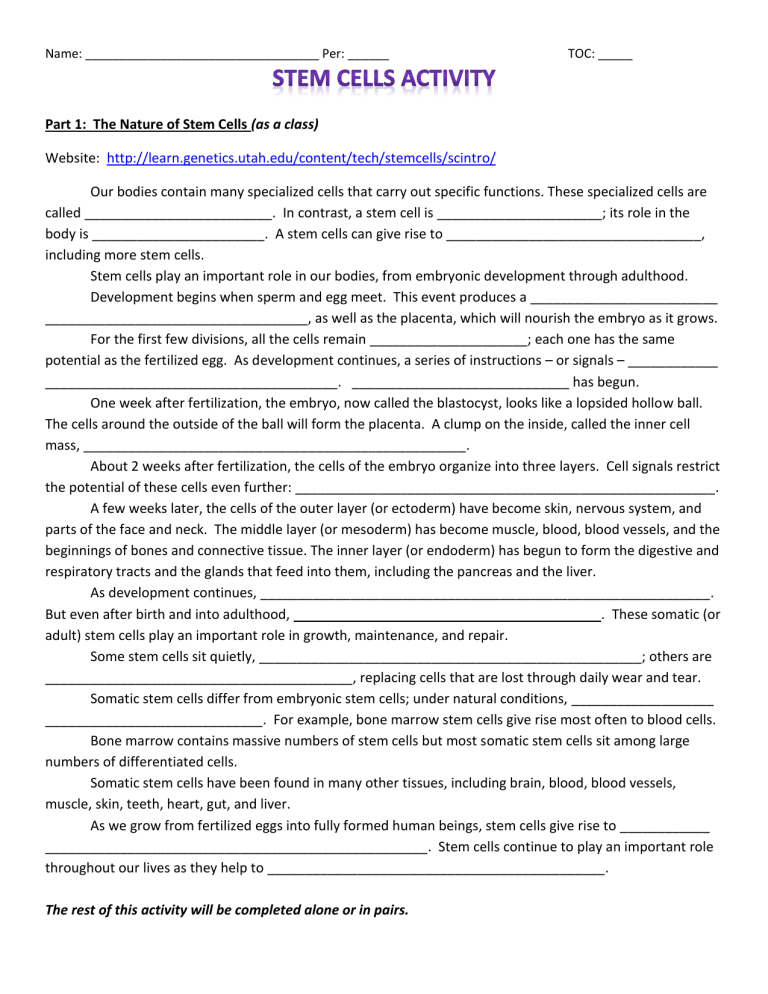
Name: __________________________________ Per: ______ TOC: _____ Part 1: The Nature of Stem Cells (as a class) Website: http://learn.genetics.utah.edu/content/tech/stemcells/scintro/ Our bodies contain many specialized cells that carry out specific functions. These specialized cells are called _________________________. In contrast, a stem cell is ______________________; its role in the body is _______________________. A stem cells can give rise to __________________________________, including more stem cells. Stem cells play an important role in our bodies, from embryonic development through adulthood. Development begins when sperm and egg meet. This event produces a _________________________ ___________________________________, as well as the placenta, which will nourish the embryo as it grows. For the first few divisions, all the cells remain _____________________; each one has the same potential as the fertilized egg. As development continues, a series of instructions – or signals – ____________ _______________________________________. _____________________________ has begun. One week after fertilization, the embryo, now called the blastocyst, looks like a lopsided hollow ball. The cells around the outside of the ball will form the placenta. A clump on the inside, called the inner cell mass, ___________________________________________________. About 2 weeks after fertilization, the cells of the embryo organize into three layers. Cell signals restrict the potential of these cells even further: ________________________________________________________. A few weeks later, the cells of the outer layer (or ectoderm) have become skin, nervous system, and parts of the face and neck. The middle layer (or mesoderm) has become muscle, blood, blood vessels, and the beginnings of bones and connective tissue. The inner layer (or endoderm) has begun to form the digestive and respiratory tracts and the glands that feed into them, including the pancreas and the liver. As development continues, ____________________________________________________________. But even after birth and into adulthood, _________________________________________. These somatic (or adult) stem cells play an important role in growth, maintenance, and repair. Some stem cells sit quietly, ___________________________________________________; others are _________________________________________, replacing cells that are lost through daily wear and tear. Somatic stem cells differ from embryonic stem cells; under natural conditions, ___________________ _____________________________. For example, bone marrow stem cells give rise most often to blood cells. Bone marrow contains massive numbers of stem cells but most somatic stem cells sit among large numbers of differentiated cells. Somatic stem cells have been found in many other tissues, including brain, blood, blood vessels, muscle, skin, teeth, heart, gut, and liver. As we grow from fertilized eggs into fully formed human beings, stem cells give rise to ____________ ___________________________________________________. Stem cells continue to play an important role throughout our lives as they help to _____________________________________________. The rest of this activity will be completed alone or in pairs. Name: __________________________________ Per: ______ TOC: _____ Part 2: Types of stem cells Go to the website: http://learn.genetics.utah.edu/content/tech/stemcells/ Click on “Stem Cell Quick Reference.” Write a quick summary on each type of stem cell in your own words. On the diagram, write in the steps or missing information. Description of Stem Cell Type: Diagram: Embryonic Stem Cells (ES): Somatic Stem Cells (a.k.a. adult stem cells): Name: __________________________________ Per: ______ Induced Pluripotent Stem Cells (iPS): Stem Cells and Therapeutic Cloning: 1. How do stem cells play a role in therapeutic cloning? 2. What are some special considerations that doctors/scientists have to consider? 3. What are some ethical issues surrounding stem cells and their use in therapeutic cloning? TOC: _____ Name: __________________________________ Per: ______ TOC: _____ Part 3: Stem-Cell-Based Therapies Go to http://www.hhmi.org/biointeractive/stem-cell-based-therapies and click play. Scan through the different slides and read about the different ways stem cells are being used. Pick two that you find most interesting and describe them. Experimental Therapy 1: _______________________ Experimental Therapy 2: _______________________ Part 4: The Controversy Read the following article about the controversy behind stem cell research. - Highlight any information you find interesting or shocking. - Underline any information you think is an argument against stem cell research. Star any information you think is an argument for stem cell research. When you are finished, answer the reflection/opinion questions The Controversy The isolation of human embryonic stem cells in 1998 thrust stem cell research into a volatile national debate tied to the fight over abortion. Deriving embryonic stem cells, and destroying an embryo in the process, raised profound ethical questions. Most revolve around the question of when life begins. Is an embryo a person? Should we forego embryonic stem cell research to protect the embryo? Is it right to negate a potential life for benefits that are unproven? Should researchers avoid this ethical minefield and redouble their efforts with adult stem cells? The Case Against Using Embryonic Stem Cells Objections to deriving human embryonic stem cells arise from the contention that human embryos are nothing less than individual beings in the earliest stages of life. As some members of a bioethics council appointed by President Bush put it in 2002, "We find it disquieting, even somewhat ignoble, to treat what are in fact the seeds of the next generation as mere raw material for satisfying the needs of our own." Those opposed to using embryonic stem cells contend that the benefits from the cells are speculative today, while the Name: __________________________________ Per: ______ TOC: _____ medical applications of adult stem cells have been shown for years. "Embryonic stem cells have not helped a single human patient or demonstrated any therapeutic benefit," reads a statement by the United States Conference of Catholic Bishops. "By contrast, adult stem cells and other ethically acceptable alternatives have already helped hundreds of thousands of patients, and new clinical uses expand almost weekly." Many on this side of the argument cite the recent studies suggesting that adult stem cells can change type, or transdifferentiate. If researchers could isolate enough adult stem cells, couldn't they, instead of embryonic stem cells, be used as replacement tissue? Some scientists even think it might be possible to "reprogram" adult stem cells back to an embryonic-cell-like state -- again providing a source for replacement tissue without the moral objections. An added benefit of this technique would be that the cells come from the patient's own body and thus are less likely to be rejected. Another issue with using embryonic stem cells concerns their ability to divide indefinitely. Studies in animals have shown that embryonic stem cells sometimes form tumors called "teratomas" or develop into a mixed collection of partially formed tissue. This could make injecting them into human patients risky. Adult stem cells, on the other hand, are not thought to pose such risks. The Case for Using Embyronic Stem Cells Many scientists do not think adult stem cells offer the same therapeutic and research potential as embryonic stem cells. Adult stem cells are difficult to isolate, and they do not proliferate well in culture. There's little proof, researchers argue, of a wide array of human adult stem cells that can differentiate into multiple tissue types. Some studies that appeared to show adult stem cells transforming into other cell types have been called into question by more recent findings, and evidence seems to indicate that adult stem cells may not possess the same capacity to give rise to any cell type as embryonic stem cells do. But despite the questions, the consensus among most scientists is that research on both stem cell types should continue on parallel tracks. Even those who have made their mark working with adult stem cells, such as Catherine Verfaillie of the University of Minnesota, hold this view. "We will not know which stem cells, adult or embryonic, are most useful in treating a particular disease without side by side comparison of adult and embryonic stem cells," Verfaillie wrote on February 4, 2002 in a letter submitted to Pennsylvania Senator Arlen Specter. And in 2001, a letter from 40 Nobel Laureates to President Bush stated: "It is premature to conclude that adult stem cells have the same potential as embryonic stem cells -- and that potential will almost certainly vary from disease to disease ... Therefore, for disorders that prove not to be treatable with adult stem cells, impeding human pluripotent stem cell research risks unnecessary delay for millions of patients who may die or endure needless suffering while the effectiveness of adult stem cells is evaluated." Many disease sufferers consider embryonic stem cells to be their only lifeline. Karen Miner, 52, has been paralyzed from the shoulders down after her car went into a ravine during a rainstorm 11 years ago. In 1998, she co-founded Californians for Cure, which advocates for spinal cord and embryonic stem cell research in California. Miner doesn't understand why "pro-life" forces are aligned against her cause. "They really don't understand that it's not destroying a life, it's saving a life," she says. "I do not believe these cells are children. Blood cells are alive, and so are skin cells. We cut into them during surgery, but no one considers that murder. They make it sound like there are people growing out in warehouses that we take body parts from." Name: __________________________________ Per: ______ TOC: _____ Finally, in answer to those who consider destruction of an embryo unjustified even if it saves a life, those favoring embryonic stem cell research point out that IVF-created embryos often get discarded, so they should be put to use rather than wasted. Reflection/Opinion Write a paragraph describing your viewpoint on the controversy and the reason behind it.



